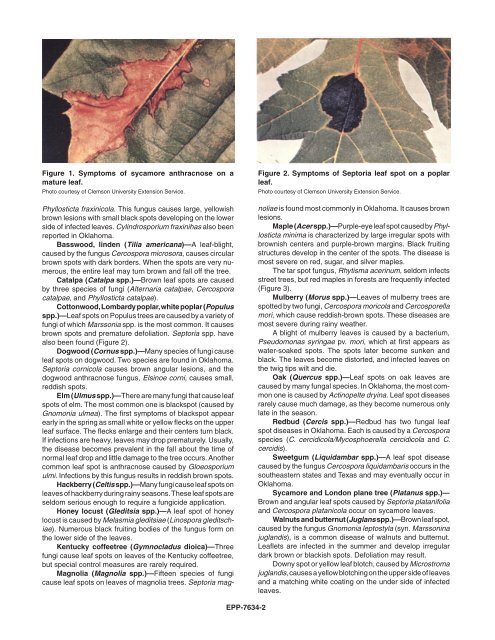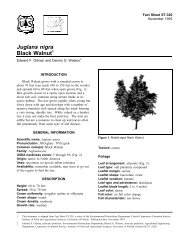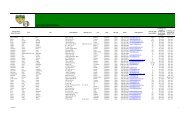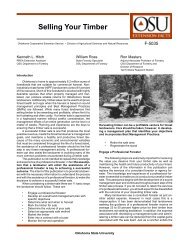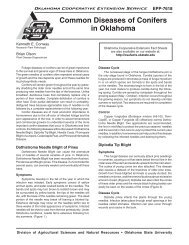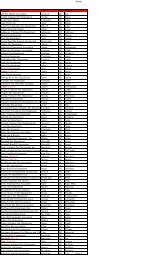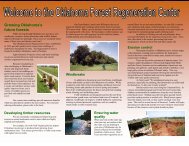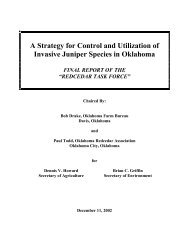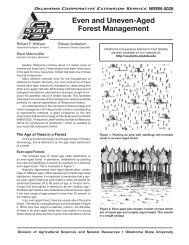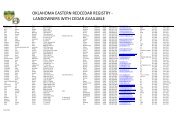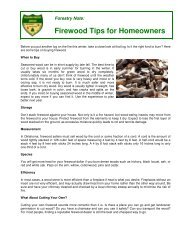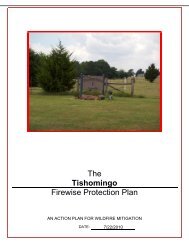Anthracnose and Other Common Leaf Diseases of Deciduous ...
Anthracnose and Other Common Leaf Diseases of Deciduous ...
Anthracnose and Other Common Leaf Diseases of Deciduous ...
Create successful ePaper yourself
Turn your PDF publications into a flip-book with our unique Google optimized e-Paper software.
Figure 1. Symptoms <strong>of</strong> sycamore anthracnose on a<br />
mature leaf.<br />
Photo courtesy <strong>of</strong> Clemson University Extension Service.<br />
Figure 2. Symptoms <strong>of</strong> Septoria leaf spot on a poplar<br />
leaf.<br />
Photo courtesy <strong>of</strong> Clemson University Extension Service.<br />
Phyllosticta fraxinicola. This fungus causes large, yellowish<br />
brown lesions with small black spots developing on the lower<br />
side <strong>of</strong> infected leaves. Cylindrosporium fraxinihas also been<br />
reported in Oklahoma.<br />
Basswood, linden (Tilia americana)—A leaf‐blight,<br />
caused by the fungus Cercospora microsora, causes circular<br />
brown spots with dark borders. When the spots are very numerous,<br />
the entire leaf may turn brown <strong>and</strong> fall <strong>of</strong>f the tree.<br />
Catalpa (Catalpa spp.)—Brown leaf spots are caused<br />
by three species <strong>of</strong> fungi (Alternaria catalpae, Cercospora<br />
catalpae, <strong>and</strong> Phyllosticta catalpae).<br />
Cottonwood, Lombardy poplar, white poplar (Populus<br />
spp.)—<strong>Leaf</strong> spots on Populus trees are caused by a variety <strong>of</strong><br />
fungi <strong>of</strong> which Marssonia spp. is the most common. It causes<br />
brown spots <strong>and</strong> premature defoliation. Septoria spp. have<br />
also been found (Figure 2).<br />
Dogwood (Cornus spp.)—Many species <strong>of</strong> fungi cause<br />
leaf spots on dogwood. Two species are found in Oklahoma.<br />
Septoria cornicola causes brown angular lesions, <strong>and</strong> the<br />
dogwood anthracnose fungus, Elsinoe corni, causes small,<br />
reddish spots.<br />
Elm (Ulmus spp.)—There are many fungi that cause leaf<br />
spots <strong>of</strong> elm. The most common one is blackspot (caused by<br />
Gnomonia ulmea). The first symptoms <strong>of</strong> blackspot appear<br />
early in the spring as small white or yellow flecks on the upper<br />
leaf surface. The flecks enlarge <strong>and</strong> their centers turn black.<br />
If infections are heavy, leaves may drop prematurely. Usually,<br />
the disease becomes prevalent in the fall about the time <strong>of</strong><br />
normal leaf drop <strong>and</strong> little damage to the tree occurs. Another<br />
common leaf spot is anthracnose caused by Gloeosporium<br />
ulmi. Infections by this fungus results in reddish brown spots.<br />
Hackberry (Celtis spp.)—Many fungi cause leaf spots on<br />
leaves <strong>of</strong> hackberry during rainy seasons. These leaf spots are<br />
seldom serious enough to require a fungicide application.<br />
Honey locust (Gleditsia spp.)—A leaf spot <strong>of</strong> honey<br />
locust is caused by Melasmia gleditsiae (Linospora gleditschiae).<br />
Numerous black fruiting bodies <strong>of</strong> the fungus form on<br />
the lower side <strong>of</strong> the leaves.<br />
Kentucky c<strong>of</strong>feetree (Gymnocladus dioica)—Three<br />
fungi cause leaf spots on leaves <strong>of</strong> the Kentucky c<strong>of</strong>feetree,<br />
but special control measures are rarely required.<br />
Magnolia (Magnolia spp.)—Fifteen species <strong>of</strong> fungi<br />
cause leaf spots on leaves <strong>of</strong> magnolia trees. Septoria magnoliae<br />
is found most commonly in Oklahoma. It causes brown<br />
lesions.<br />
Maple (Acer spp.)—Purple‐eye leaf spot caused by Phyllosticta<br />
minima is characterized by large irregular spots with<br />
brownish centers <strong>and</strong> purple‐brown margins. Black fruiting<br />
structures develop in the center <strong>of</strong> the spots. The disease is<br />
most severe on red, sugar, <strong>and</strong> silver maples.<br />
The tar spot fungus, Rhytisma acerinum, seldom infects<br />
street trees, but red maples in forests are frequently infected<br />
(Figure 3).<br />
Mulberry (Morus spp.)—Leaves <strong>of</strong> mulberry trees are<br />
spotted by two fungi, Cercospora moricola <strong>and</strong> Cercosporella<br />
mori, which cause reddish‐brown spots. These diseases are<br />
most severe during rainy weather.<br />
A blight <strong>of</strong> mulberry leaves is caused by a bacterium,<br />
Pseudomonas syringae pv. mori, which at first appears as<br />
water‐soaked spots. The spots later become sunken <strong>and</strong><br />
black. The leaves become distorted, <strong>and</strong> infected leaves on<br />
the twig tips wilt <strong>and</strong> die.<br />
Oak (Quercus spp.)—<strong>Leaf</strong> spots on oak leaves are<br />
caused by many fungal species. In Oklahoma, the most common<br />
one is caused by Actinopelte dryina. <strong>Leaf</strong> spot diseases<br />
rarely cause much damage, as they become numerous only<br />
late in the season.<br />
Redbud (Cercis spp.)—Redbud has two fungal leaf<br />
spot diseases in Oklahoma. Each is caused by a Cercospora<br />
species (C. cercidicola/Mycosphoerella cercidicola <strong>and</strong> C.<br />
cercidis).<br />
Sweetgum (Liquidambar spp.)—A leaf spot disease<br />
caused by the fungus Cercospora liquidambaris occurs in the<br />
southeastern states <strong>and</strong> Texas <strong>and</strong> may eventually occur in<br />
Oklahoma.<br />
Sycamore <strong>and</strong> London plane tree (Platanus spp.)—<br />
Brown <strong>and</strong> angular leaf spots caused by Septoria platanifolia<br />
<strong>and</strong> Cercospora platanicola occur on sycamore leaves.<br />
Walnuts <strong>and</strong> butternut (Juglans spp.)—Brown leaf spot,<br />
caused by the fungus Gnomonia leptostyla (syn. Marssonina<br />
jugl<strong>and</strong>is), is a common disease <strong>of</strong> walnuts <strong>and</strong> butternut.<br />
<strong>Leaf</strong>lets are infected in the summer <strong>and</strong> develop irregular<br />
dark brown or blackish spots. Defoliation may result.<br />
Downy spot or yellow leaf blotch, caused by Microstroma<br />
jugl<strong>and</strong>is, causes a yellow blotching on the upper side <strong>of</strong> leaves<br />
<strong>and</strong> a matching white coating on the under side <strong>of</strong> infected<br />
leaves.<br />
EPP-7634-


